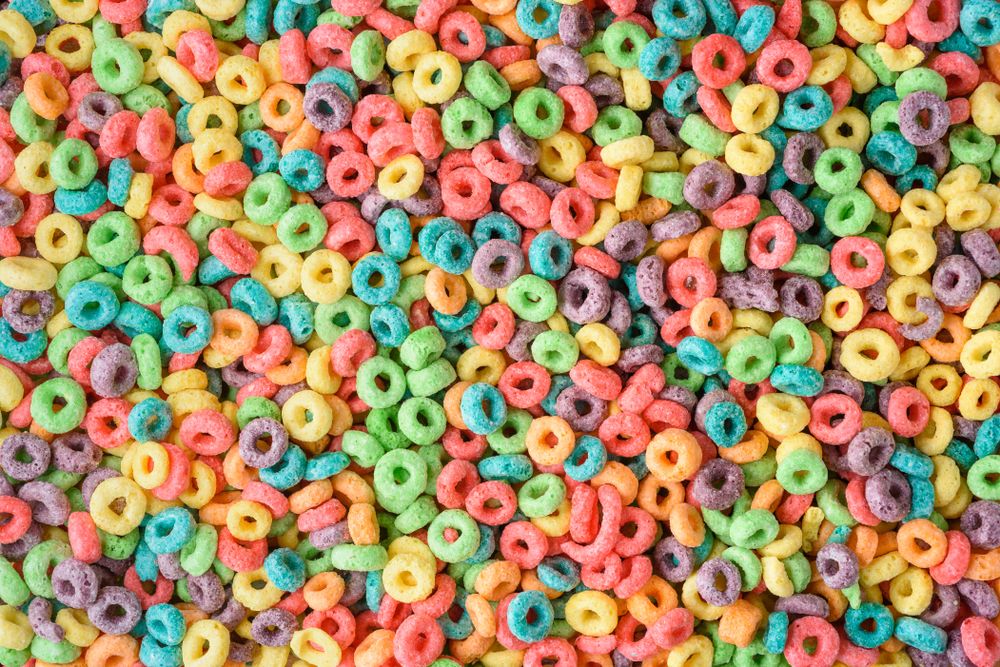
When browsing packaged foods at the grocery store, you likely compare nutrition facts to choose the best option. Checking for calories, nutrients, and how well a product aligns with your health goals is a great start. However, many people overlook the ingredient list, which often reveals even more about a product’s benefits—or potential drawbacks.
Packaged foods offer convenience, flavor, and nutrients, but achieving bold flavors, vibrant colors, and extended shelf life often involves the use of questionable ingredients. While focusing on minimally processed, whole foods can help you avoid unnecessary additives, it’s important to know what to watch for when reaching for packaged items.
Here are 10 common ingredients on nutrition labels that should raise a red flag. And for more guidance on healthy eating, check out 30 Healthiest Foods To Eat Every Day.
High Fructose Corn Syrup

From soda and juice to canned fruit, cereal, and dairy products, high fructose corn syrup (HFCS) is a common ingredient in packaged foods and drinks. Over the last several decades, HFCS has become a common ingredient as manufacturers look for cheaper ways to sweeten their products. This ingredient is cheaper than sugar, yet provides a similar sweetness, and can aid in the texture and moisture retention in food. However, research suggests HFCS may increase risk of metabolic dysregulation and obesity. Not to mention, HFCS is a source of empty calories that not only contributes to weight, but may also negatively impact dental health.
The American Heart Association advises limiting added sugars, including HFCS, to fewer than 25 grams per day for women and 36 grams per day for men. Reading nutrition labels carefully can help you steer clear of this problematic ingredient.
Sodium Nitrite

Sodium nitrite is a common preservative found in cured meats such as BBQ, deli meat, and jerky. It’s used to retain the meat's natural color, but it comes with potential health concerns. Research indicates that sodium nitrite in processed meats can form carcinogenic compounds, which may increase the risk of cancer.
Fortunately, many brands now offer nitrate-free cured meats. Taking the time to compare ingredient lists can help you find these healthier alternatives—and that small effort can make a big difference in improving the quality of your grocery choices.
Red No. 3

Extensive research has raised concerns about the safety of food dyes, and Red No. 3 is no exception. This dye is often added to foods and drinks to enhance their appearance, particularly in products marketed to children. While its bright color can make these items more appealing, it may pose risks to your health.
In one study, rats exposed to Red No. 3 showed a higher incidence of thyroid tumors. Due to its potential carcinogenic effects in animals, regulators have already banned its use in cosmetic products.
Given these risks, it’s best to avoid Red No. 3 and minimize your intake of food dyes and artificial colorings whenever possible.
Titanium Dioxide

Although titanium dioxide is banned from use in food in Europe, it remains an ingredient in many popular products in the U.S. It’s often used to create a bright white color in items like coffee creamer, gum, frosting, and pudding.
Research indicates that titanium dioxide may accumulate in the body over time, potentially causing DNA and chromosomal damage. Notably, the FDA has not independently reviewed its safety since its approval in the 1960s but is now reconsidering its use in food.
Until a final decision is reached, it’s wise to avoid products containing titanium dioxide whenever possible.
Tertiary Butylhydroquinone

TBHQ, or tertiary butylhydroquinone, is a widely used food additive that acts as a preservative, often appearing alongside other questionable ingredients. The Center for Science in the Public Interest (CSPI) advises avoiding TBHQ, pointing to research that linked it to a higher incidence of tumors in rats.
This additive is commonly found in snack foods, cereals, and crackers, including many products marketed to children. Despite its prevalence, increasing concerns about its potential health risks have placed TBHQ under heightened scrutiny.
BHA & BHT

Butylated hydroxyanisole (BHA) and butylated hydroxytoluene (BHT) are preservatives frequently added to processed foods like crackers and cereals to prevent fats from becoming rancid. While the FDA deems BHA and BHT safe within specific limits, animal studies suggest that BHA may increase the risk of cancer in humans. Additionally, research indicates that both BHA and BHT could interfere with sex hormones.
Due to these concerns, many manufacturers are opting for safer, less controversial alternatives, such as vitamin E, to preserve their products.
Aspartame

Aspartame, one of the most widely used artificial sweeteners, is commonly found in soda, energy drinks, gum, and various low-sugar products. While some individuals report mild side effects like headaches and dizziness, emerging research points to more serious concerns. Studies have linked aspartame to issues such as diabetes, obesity, glucose and insulin intolerance, and disruptions to gut microbiota.
Over the years, conflicting research regarding aspartame's potential carcinogenic properties has raised ongoing concerns, providing a strong case for limiting its consumption.
Potassium Bromate

Potassium bromate is a common additive in flour and baked bread products, traditionally used to boost bread volume and improve texture. While most bromate breaks down into harmless bromide during baking, studies have shown that bromate itself can cause cancer in animals. Due to these findings, its use has been banned in most countries around the world.
Although many flour millers and food manufacturers have eliminated potassium bromate from their processes, it’s still wise to check ingredient lists. Even small residual amounts can pose unnecessary health risks, making it best to avoid products that contain this additive.
Acesulfame Potassium

Acesulfame potassium (Ace-K), a zero-calorie artificial sweetener, is commonly used in diet drinks, low-sugar gum, and candy. While opinions and research on its safety remain mixed, some studies suggest potential health risks. For instance, one study indicated that Ace-K may impact cognitive function. Early safety tests conducted in the 1970s even raised concerns about carcinogenic effects in rats, though the tests were later criticized for flaws in their methodology.
To stay on the safe side, it’s best to limit your consumption of products containing this artificial sweetener.
Caramel Coloring

Caramel coloring, commonly found in soda, baked goods, and cooked meats, may carry potential health risks. When produced using ammonia, caramel coloring can form 4-Methylimidazole (4-MEI), a compound that studies have linked to lung cancer and leukemia in mice and rats.
While small amounts of caramel coloring in products like soy sauce and Worcestershire sauce are unlikely to pose significant risks, regular soda drinkers may be consuming a far more concerning amount. Limiting soda and other heavily colored products can help reduce exposure.

